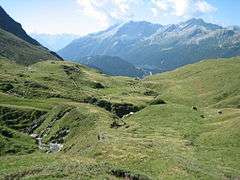Moesa District
Moesa District, often referred to as Moesano, is a former administrative district in the canton of Graubünden, Switzerland. It had an area of 473.74 km2 (182.91 sq mi) corresponding to the Val Mesolcina, the valley of the eponymous Moesa River. It was replaced with the Moesa Region on 1 January 2017 as part of a reorganization of the Canton.[1]
Moesa Distretto di Moesa | |
|---|---|
District | |
 | |
| Country | |
| Canton | |
| Capital | Roveredo |
| Area | |
| • Total | 473.74 km2 (182.91 sq mi) |
| Population (December 2015) | |
| • Total | 8,125 |
| • Density | 17/km2 (44/sq mi) |
| Time zone | UTC+1 (CET) |
| • Summer (DST) | UTC+2 (CEST) |
| Municipalities | 14 |

Moesa scenery
It had a population of 8,125 in 2015. The official language is Italian.
It consisted of three Kreise (circles) and fourteen municipalities:
| Calanca circle | ||||
|---|---|---|---|---|
| Municipality | Population (31 December 2018)[2] | Area (km²) | ||
| Buseno | 87 | 11.26 | ||
| Calanca | 199 | 37.72 | ||
| Castaneda | 275 | 3.94 | ||
| Rossa | 148 | 58.93 | ||
| Santa Maria in Calanca | 109 | 9.32 | ||
Languages
The official language of Moesa is Italian, traditionally the Western Lombard dialect spoken by the native population.
| Languages of Moesa District, GR | ||||||
| Languages | Census 2000 | |||||
| Number | Percent | |||||
| German | 528 | 7.1% | ||||
| Romansh | 10 | 0.1% | ||||
| Italian | 6,578 | 88.0% | ||||
| TOTAL | 7,471 | 100% | ||||
Mergers and name changes
On 1 January 2015 the former municipalities of Arvigo, Braggio, Selma and Cauco merged to form the new municipality of Calanca.[3]
gollark: Come to think of it, we could probably put a lot of computing hardware into the solar power stuff, which presumably has a lot of power and some cooling.
gollark: The main constraints for high-performance computer stuff *now* are heat and power, or I guess sometimes networking between nodes.
gollark: Also, for random real-world background, there are only two companies making (high-performance, actually widely used) CPUs: Intel and AMD, and two making GPUs: AMD and Nvidia. Other stuff (flash storage, mainboards, RAM, whatever else) is made by many more manufacturers. Alienware and whatnot basically just buy parts from them, possibly design their own cases (and mainboards for laptops, to some extent), and add margin.
gollark: You could just have them require really powerful nonquantum computers.
gollark: Quantum computing accelerates specific workloads, not just *everything*.
References
- Swiss Federal Statistical Office - Amtliches Gemeindeverzeichnis der Schweiz - Mutationsmeldungen 2016 accessed 16 February 2017
- Swiss Federal Statistical Office - STAT-TAB, online database – Ständige und nichtständige Wohnbevölkerung nach institutionellen Gliederungen, Geburtsort und Staatsangehörigkeit (in German) accessed 23 September 2019
- Amtliches Gemeindeverzeichnis der Schweiz published by the Swiss Federal Statistical Office (in German) accessed 2 January 2013
This article is issued from Wikipedia. The text is licensed under Creative Commons - Attribution - Sharealike. Additional terms may apply for the media files.